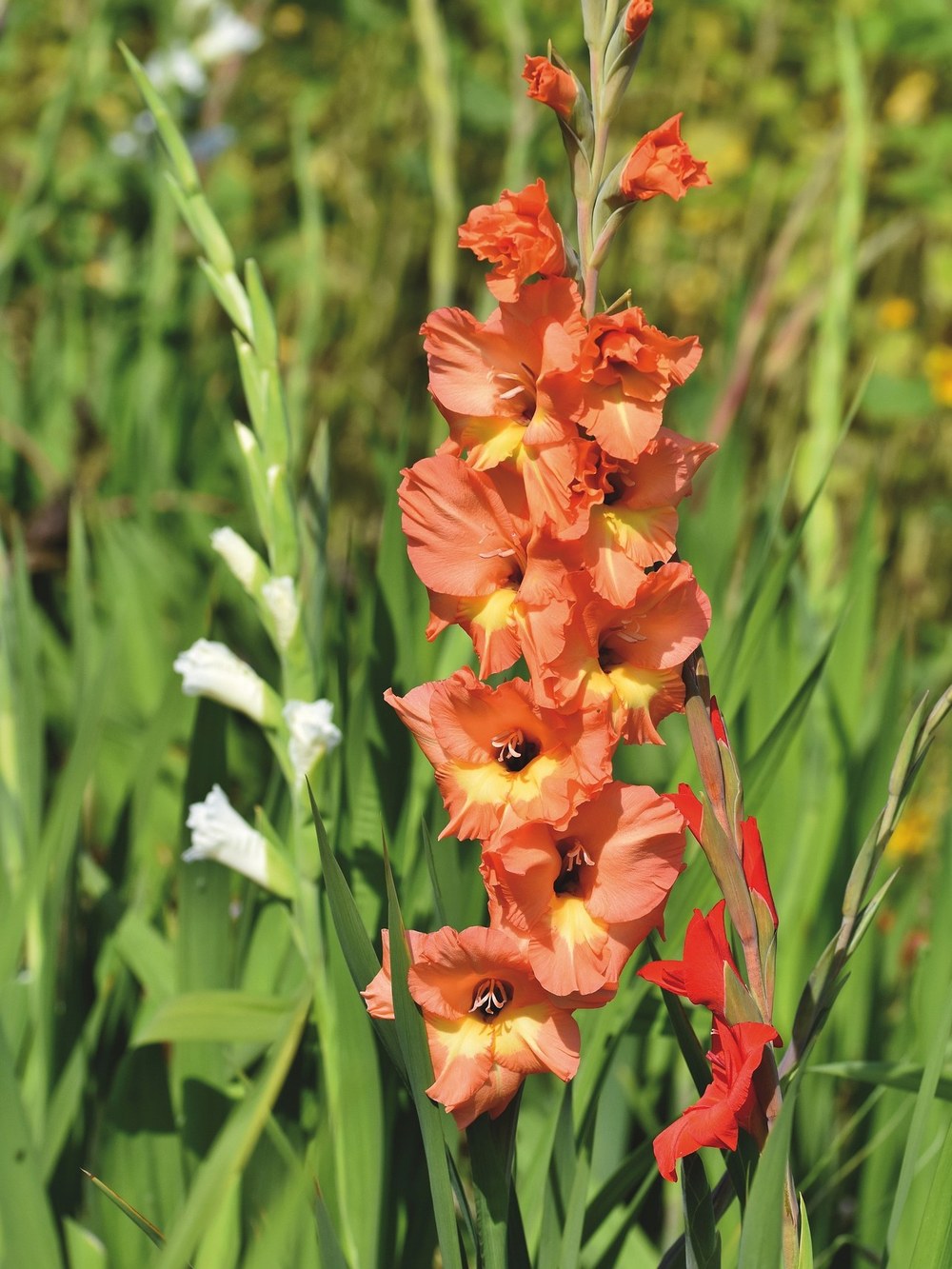Posted: August 6, 2021
One of summer’s most colorful flowers is also the birth month flower of August. It is the gladiolus. This classical summer-bloomer is unique in that its flowers grow from a tall spike, lined with pointed sword-shaped medium-green leaves.

Photo from Pixabay
The gladiolus is a member of the iris family, Iridaceae, its nickname "sword lily" comes from its Latin name "gladius" meaning sword. It is known as the flower of the gladiators. In Ancient Rome, gladiators would fight "to the death of gladioli." Spectators would cover the winner in colorful gladiolus flowers. The gladiolus has been associated as a symbol of strength, moral character, honor, intelligence, and victory. The flower is also a symbol for healing.
Though their sword and battlefield reputation suggest fighting and heroism, Victorian romantics felt that the gladiolus beauty could pierce someone's heart with love. Therefore infatuation, love at first sight, faithfulness, and calm were added to the list of traditional floral meanings.
Beyond these interpretations, the birth flower for August carries other meanings based on its color.
- Red gladiolus symbolize love, romance, passion, and the perfect way of expressing how much you adore someone.
- Pink gladiolus symbolize compassion and love but are more subdued in their meaning. You can give a pink gladiolus to someone you love but can also just show a friend that you care about them.
- White gladiolus symbolize innocence and purity. They also mean profound respect for someone you admire or hold dear to your heart. White gladiolus are commonly used in wedding bouquets or arrangements.
- Yellow gladiolus symbolize joy and friendship. The color also stands for positive energy and is a meaningful choice for a friend who needs a pick-me-up.
- Purple gladiolus symbolize charm, grace, royalty, fortune, and beauty. Purple gladiolus make a wonderful gift for almost anyone.
The gladiolus is native to tropical regions of Africa and areas around the Mediterranean and Middle East. Mediterranean and British peoples used gladiolus flowers to treat physical illness. Around the 1820s, European gardeners began to seriously cultivate gladiolus and developed new shades and hybrid varieties which became very popular in gardens and as cut flowers. They first appeared in American nurseries around 1891 and became an extremely coveted perennial for colorful plantings.
Commonly called "glads," these majestic flowering plants reach between 2 to 5 feet in height. Their showy funnel-shaped blooms also range in size--from "miniature" flowers less than 3 inches in diameter, to "giant" flowers greater than 5 inches across.
Plant gladiola corms in the spring, when the danger of frost has passed, and the soil has warmed to at least 55°F. Site corms in full sun and set them about 4 inches deep with the pointed end facing up. Cover with soil and press firmly.
Space the corms 6 to 8 inches apart. Gladiolus like well-drained, moderately fertile soil. They will not do well in heavy, wet soil. Water the corms thoroughly at planting. Once they have begun to grow, put a 2- to 4-inch layer of mulch around the plants to keep the soil moist and help prevent weeds. Water them moderately during the growing season to keep the soil moistened but not wet. Remove the faded or dead flowers to ensure continuous blooms.
Gladiolus can be susceptible to disease and pests. Gladiolus corm rot (Fusarium wilt), gray mold, viruses, aster yellows, spider mites, thrips and aphids can all affect gladiolus.
Parts of the flower are poisonous and should not be kept within reach of children or animals as they can cause allergic reactions such as skin irritation.
If you want to grow gladiolus for cut flowers, plant them in rows. It is easier to tend the plants and to harvest the flowers this way. If you want them planted with other flowers in borders or beds, plant the corms in groups of seven or more for the best effect. The taller varieties, which need to be staked, can be placed in the back of a garden to complement shorter plants.
When the weather begins to cool in USDA (United States Department of Agriculture) Hardiness Zones 7 or colder, which includes Pennsylvania, dig up gladiola corms once the foliage has faded after the first fall frost. A light frost can kill the foliage, but not necessarily the rest of plant. Be sure to dig up the corms before a hard freeze however or the plants could be killed.
Use a spade to remove the entire plant, grasping the top to pull it gently out of the soil. Avoid injury to corms while digging. Shake off loose soil (do not wash off) and discard any damaged corms. Cut the stalk down to 1-2 inches above the corm.
Do not remove the husks on the corms but instead, dust the corms with a fungicide ("bulb dust") to help avoid disease problems. Place dust and bulbs in a paper bag and shake vigorously. Remove and store the corms in paper or cloth bags, pantyhose, or onion sacks. Stack or hang them so air can circulate. Store the corms at 35 to 45°F with low humidity. A cool basement is often sufficient, but do not allow corms to freeze.
Replant corms in the spring for another year of beautiful blooms and amazing color!
by Joan Banyas, Penn State Master Gardener Trainee of Luzerne County

